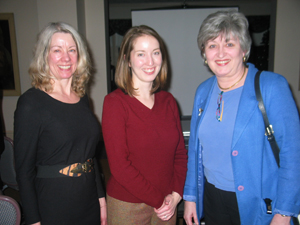 |
Dr. Susan Swindells, right, with Sara Pirtle, coordinator of UNMC International Studies and Programs, left, and Stephanie Hartman (M-2), SAGH fundraising chairwoman and Wine & Cheese event planner. |
Three days earlier, on Jan. 25, those attending the UNMC Student Alliance for Global Health (SAGH) 2007 “Wine & Cheese Benefit” received a detailed overview of this catastrophic development from guest speaker Susan Swindells, M.B.B.S., medical director of the UNMC HIV Clinic and the Terry K. Watanabe Chairwoman of HIV Research.
In her presentation titled, “Global Health Issues of HIV/TB Co-Infection,” Dr. Swindells reviewed the actual research study that led to The New York Times story. The study revealed a TB strain so virulent that it killed 52 of 53 patients in a median time of 16 days after diagnosis.
“It’s an astonishing development,” Dr. Swindells said.
Dr. Swindells showed a photograph of a ward in a hospital where patients died from the extremely resistant TB. Nobody in the photo wore face masks and there was no air filtration system. In fact, several health care workers at the facility also contracted and died from the virulent strain.
Reminding the audience that people don’t die of AIDS but rather from infections the patients’ debilitated immune systems can’t overcome, Dr. Swindells said TB already is the leading cause of death for AIDS patients in sub-Saharan Africa — killing more than 1.7 million people in the region each year.
Dr. Swindells showed a slide of an antique microscope from 1892. On the next slide she showed the exact same microscope being used as a diagnostic tool for identifying tuberculosis in sub-Saharan Africa in 2005.
“The primary means of identifying TB in southern Africa is still sputum on a slide under a microscope — more sophisticated testing is inaccessible for most Africans,” Dr. Swindells said. “Unfortunately, the sputum method misses half of all adult HIV-positive cases at first presentation and almost 95 percent of all children because children don’t produce the quantity of sputum on demand necessary for testing.”
Ineffective testing methods are compounded by the fact that the region also is facing a brain drain, Dr. Swindells said.
Many nurses and physicians trained in the region leave for better salaries and living conditions elsewhere, she said.
Dr. Swindells has a Zambian colleague whose clinic now has a three-day wait for service.
This means patients come to the clinic and literally camp out in front of the facility for up to three days before they are seen by a health worker, Dr. Swindells said.
“Is all of this a problem for America? Well, you can do the math,” Dr. Swindells said. “Infectious diseases proliferate and are fueled by poverty — and above all — poor living conditions, poor nutrition, poor access to quality health care, and in Africa’s case, also on-going issues of war and government corruption. Not only do these diseases travel by way of refugees, but there are now more than 14 million orphan children in Africa from AIDS. These kids will either grow up to be productive citizens for their nations or long-term sources of political instability that may affect American interests in the future.”
But Dr. Swindells remembers the early years of HIV/AIDS treatment when there was no medical means of keeping people with the disease alive. Today a diagnosis of HIV-positive can be no more demanding than a diagnosis of diabetes — eat right, follow your meds, get some exercise — and a patient may well live another 20-25 years or more.
“In the 1990’s, there was a serious virulent outbreak of tuberculosis in the New York City prison system,” Dr. Swindells said. “Within a short time, it spread from the jails to the community via released inmates. The speed and expansion of the outbreak really got everybody’s attention. The city’s public health system took a very serious response to epidemic and quelled it. Hopefully, this new study will do the same for the forces fighting AIDS and tuberculosis in Africa.”
SAGH’s annual “Wine & Cheese” fundraiser in past years has showcased a number of internationally-acclaimed physicians who have dedicated their lives to bringing medical treatment to the world’s neediest environments
Although Dr. Swindells rarely goes overseas these days, that doesn’t keep her from maintaining an extraordinary network of international colleagues. She is considered one of the world’s leading authorities on HIV/AIDS and specialists from around the globe keep her informed of rapidly breaking new developments.
SAGH is the UNMC campus organization devoted to providing students and faculty opportunities in international medicine, including a number of annual medical missions to Jamaica, Guatemala, Nicaragua, Costa Rica and the Sisseton Indian Health Service facility in South Dakota.